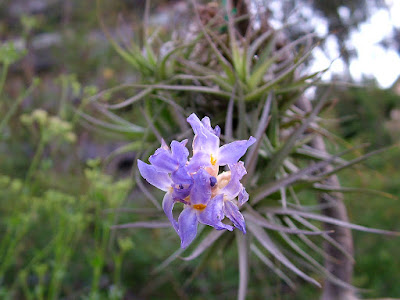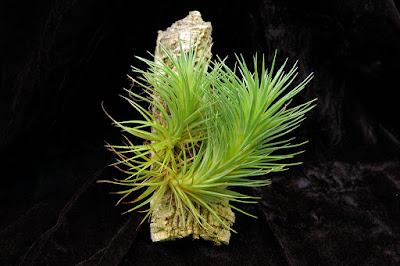Tillandsia bergeri is native to South America, more particularly of Argentina. It grows on the steep rocky cliffs at elevation of 1000 meters above sea level. It is known as one of the fastest clumping species of air plants, and grows all-year round.
Tillandsia bergeri is a species of the genus Tillandsia. This species was described by Carl Christian Mez in 1916.
IDENTIFY TILLANDSIA BERGERI AIR PLANT
Tillandsia bergeri is native to South America, more particularly of Argentina. It grows on the steep rocky cliffs at elevation of 1000 meters above sea level. It is known as one of the fastest clumping species of air plants, and grows all-year round.
It is a perennial herbaceous plant, branched, short-branched, lithophyte that are very similar to Tillandsia aeranthos when not in flower but distinguished by more leaves which are often larger, sometimes a little tighter. The leaves are medium sized (up to 15 cm, often less), quite leathery, numerous, arranged all around the stem that branches out after each flowering.
This air plant blooms from simple, with about 10 flowered, with floral bracts more or less pink and scaly, sometimes slightly greenish at the apex. The bracts of the flowering stem are scaly, slightly pink and tight against the stem. The flowers are quite small (1.5 cm long), non-tubular, blue with white in the center. The petals are more or less twisted and have a median white line. The edge of the petals is wavy.
TILLANDSIA BERGERI AIR PLANT CARE AND CULTURE
Cultural information should only be used as a guide, and should be to be adapted to suit you. Your physical location; where you grow your plants, how much time you have to devote to their care, and many other factors, will need to be taken into account. Only then can you decide on the cultural methods that best suit you and your plants.
Light:
Temperature:
The required temperature ranging from 10 to 32°C. Get it early enough in the fall if you grow it outside, so that it does not face night temperatures below 4 or 5 ° C, especially if it is wet. This species can withstand high temperatures and freezing for short periods if the plant is sufficiently large. A period of winter cold that facilitates its bloom in the spring that follows. The absence of this period of cold is often the cause of the scarcity of the bloom found by some amateurs cultivating this plant too softly indoors or in a greenhouse.
Humidity:
Good aeration is required, the plant need the humidity level of moderate to low. The plant tolerates drought periods well.
Substrate, growing media and repotting:
Tillandsia bergeri refer to be mounted on a solid substrate that does not retain water. You can glue the plant directly to the surface with a strong adhesive, or you can wire the plant to the base. Don't cover the base of the plant with moss or it may rot. It can be grown on almost any imaginable decorative mount, including shells, rocks, slate, driftwood, etc. Group them in decorative clumps for maximum effect.
This species is grown outdoors in summer in sunny conditions. Place it very close to a window indoors in the winter, the brightness must remain maximum throughout the year.
Watering:
Twice a week in summer, once a week in winter according to the luminosity and the ambient humidity. Obviously when it rains and if you grow it outside, it counts as a watering.
Fertilizer:
This air plant can be fertilized with the moderate doses. 1 to 2 times a month in the summer and 1 time a month in the winter.















COMMENTS